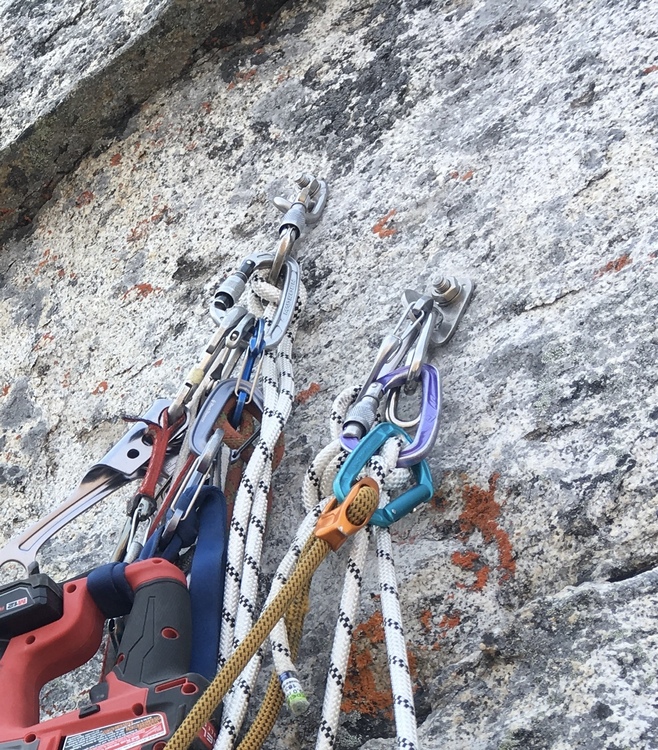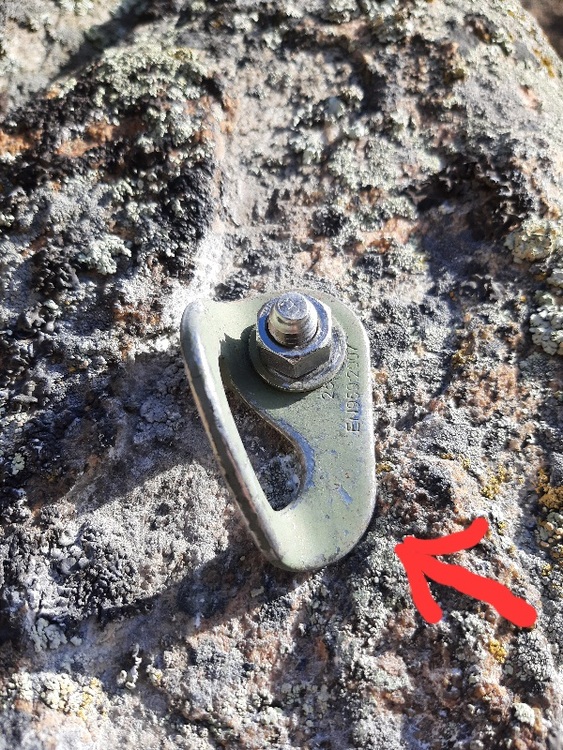Bolt hanger orientation
|
|
Because I see a lot of hangers oriented this way around certain areas of CO (I won't name any names...) I wanted to post this PSA: This hanger is rotated way too far clockwise. Of course I can't "prove it" since there's no reference point in this photo -- you'll just have to believe me. I get that sometimes it may be advantageous to do this, but generally speaking it is poorly oriented. Unless there's a natural feature (nubbin, etc.) on the right side of the hanger preventing it from self-correcting (rotating back counterclockwise), it will do just that with a good jolt. This always loosens the nut and results in a spinner. I don't know about you guys, but I don't wanna have to go back out and tighten all my bolts back down -- God knows the average bolt-clipper can't be bothered to do so nowadays, but I digress... Some companies put arrows on their hangers (Fixe used to) but most do not. Just hang a draw on it before tightening it down to figure out the correct orientation. End of rant. Flame on all you internet experts. |
|
|
When you say "spinner" are you referring to the hanger spinning or the bolt spinning in the hole? |
|
|
Fail Falling wrote: The hanger spinning for sure. As the hanger rotates counter clockwise, it'll loosen the nut. Since it's not oriented correctly, any fall will cause the hanger to rotate counter clockwise. |
|
|
This is a surprisingly overlooked detail of proper mechanical bolt installation. Just clip a draw to the hanger and maintain constant force in the direction of fall while tightening the bolt down to spec. This will orient the hanger properly to avoid torque that may loosen the nut/bolt causing the hanger to spin. |
|
|
I see this all the time with some bolters. Then they act surprised when some of their hangars end up being loose. Seems like common sense to me... |
|
|
A photo that I posted on the ST forum (RIP) several years ago: An exception might be a belay anchor on a ledge/stance with two side-by-side bolts with rings or chains that is used as a rappel anchor, either on a single-pitch route, or on a multi-pitch route where it is unlikely that a lead climber will take a (factor 2) fall onto the anchor. In this case, the primary force exerted on the hangers will be during rappelling and the force won’t be straight down but rather at an inward angle towards the point where the rope is connected. For such anchors, I’d typically rotate the left hanger slightly counterclockwise and the right hanger slightly clockwise, as shown in the photo below. This slight amount of hanger rotation is for a compromise between a force applied straight down and the force applied at the angle of the chains during rappel.
Mad Rock and the older-style Petzl hangers have an arrow, but the arrows are not oriented correctly. If the hangers are placed with the arrow pointing straight down, the hangers will rotate counterclockwise when force is applied. The arrow on the Petzl is slightly off but the Mad Rock is pretty blatant.
Maybe another reason to use Rawl/Powers 5-piece bolts? |
|
|
Rotating the hanger counterclockwise can loosen a 5 piece bolt also. |
|
|
two of the reasons why i'm a fan of glue-ins: -symmetrical orientation - equal clipping/force from either side/direction -no mechanical (loosening) parts |
|
|
Bryan’s tricks to prevent mechanical bolts in horizontal anchors from loosening are why I always install French-style, vertically offset anchors with the left bolt higher than the right. I keep the horizontal offset to 3-5 inches, with 6-9 inches of vertical offset. This prevents the left hanger from rotating counterclockwise, and also straightens out the kinks in your rope when you pull. Finally, it minimizes the amount of hardware you must carry in for remote routes. It’s a win-win-win. If you want to install lower-offs at a crag and prefer both points to be equalized, put a chain on the left bolt. Here’s the best photo I can find of a vertically offset anchor on a remote granite multi-pitch. The left bolt has a Titt rod hanger, which sadly isn’t made anymore. The right bolt has an 8mm/ 5/16” stainless quicklink and a stainless chain link instead of a rap ring. I use 3/8” links and beefy steel lower-offs on front-country cragging routes. Agreed with old that glue-ins are superior in every way except convenience and speed of installation. They’re also not very practical for installing on lead. |
|
|
There is no guarantee that the force on a hanger will be purely vertical. So some loosening is always a possibility. That's why I preach loctite. On wedge bolts anyway. |
|
|
jbak x wrote: I’ve gotten into the habit of loctiting all the nuts before I pull the fixed lines on a new route. Great recommendation. A dab of blue loctite is plenty. Don’t need red. |
|
|
Does the threadlock prevent the hangar from spinning? Or just the nut? I always thought threadlock went on the bolt threads. Or do you put it on the bottom of the nut where it contacts the hangar also? |
|
|
The clamping force of the nut keeps the hanger from spinning. Loctite just keeps the nut from loosening |
|
|
Troy Isakson wrote: What Peter said. I don't always use loctite for all wedge bolts but I do when placing the Powers. They tend to loosen more easily than others (plus the threads are cut rather than stamped, meaning you have to be careful not to overtighen, so that extra friction of the loctite helps). Blue loctite (nowadays I usually get the Harbor Freight stuff, which should be the same) is just enough to keep the nut from loosening without a wrench but allows them to easily be removed otherwise. Some argue that it can cause the bolt to spin in the hole, but I've removed hundreds of nuts without a single issue. If you experience otherwise, my guess is that the rock was too soft for that bolt type in the first place. Do not use red loctite, it'll be stuck on 'til the end of time. Also, be aware that loctite dissolves paint. So be careful applying it to your painted bolt/hangers. It can splash when hammering the bolt in. On a slightly different note: For hangers subjected to counter clockwise rotation, sometimes it works out that you can utilize the rock features such as below to keep them from spinning. There are other tricks one can use but this is the simplest if the rock allows. Just something to think about if you haven't already. |
|
|
nbrown wrote: I use red. Very very rarely an issue. If it is, a small Dremel can cut the nut off. I'm not saying there's anything wrong with blue. Just that red is not a big problem. I'm really just happy to see people using either. |

 Continue with onX Maps
Continue with onX Maps Sign in with Facebook
Sign in with Facebook

























